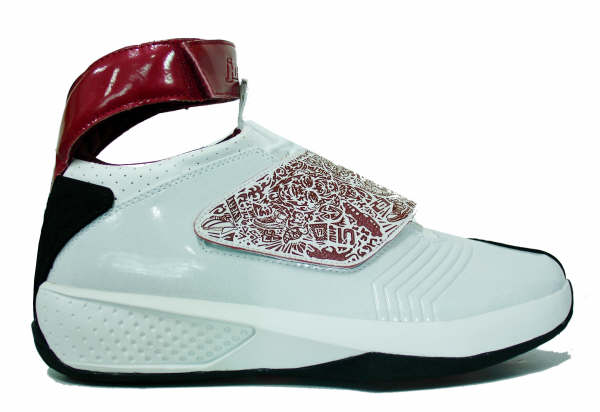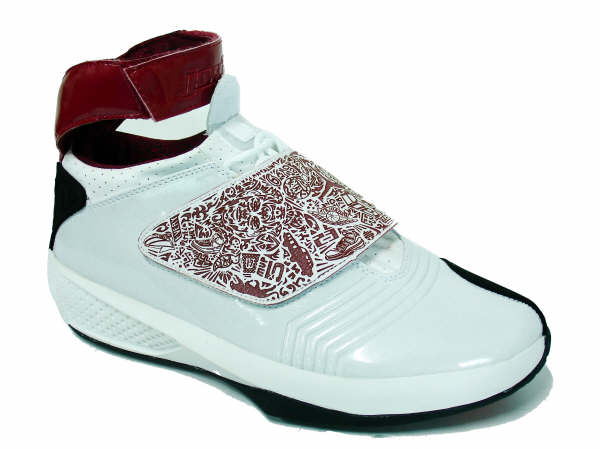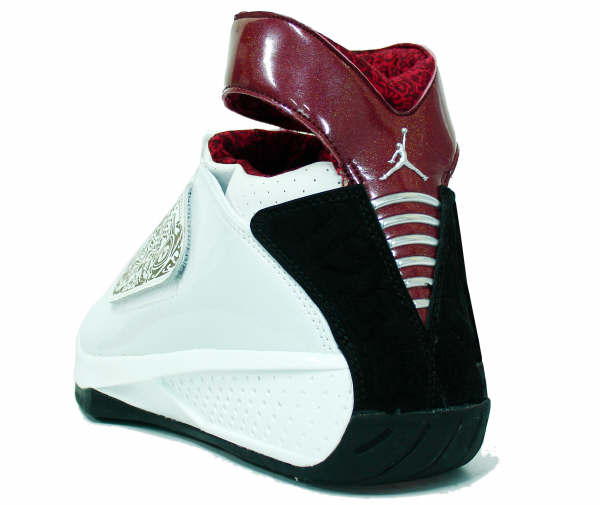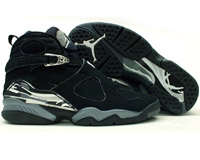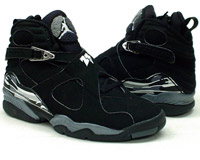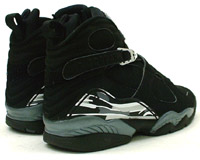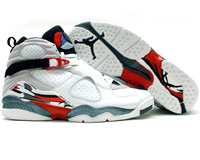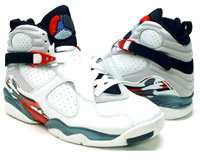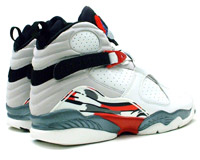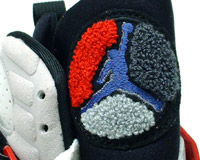The Jordan Shoe History
The Nike Air Jordan Evolution
Apart from the Air Jordan models that are being released, Jordan Brand
also provides a whole line of apparel and shoes for fashion, training, and
casual wear. Not just a basketball
shoes, the
AIR
The Air Jordan I was designed by Peter Moore and marked a new era in the
design of basketball shoes. The black/red model was banned by the NBA due to
NBA color rules and this actually helped to create
more publicity and more interest for the shoes. Whether this was a marketing
ploy from Nike or not, it helped to generate the interest that, to date, has supported nineteen different
The original Air
The white/black-red and black/red
The first Air






AIR JORDAN II - Released November 1986
The Air Jordan II was designed by Bruce Kilgore and just as its
predecessor it showed a great innovative design. The low-tops were produced in
Surprisingly this is the only original Air
The white/black AJ II's were retroed
in 1994 in limited quantities. Just like the Air Jordan Retro I they sold very
poorly and were often found deeply discounted at shoe stores nationwide. The
Jordan II have been recently re-retroed,
finally in black leather. The Jordan
Retro II is also available in white/varsity red-black.
Along with a return trip to the All-Star game, Michael wins his first in a
series of scoring titles, as well as the Slam-Dunk Championship. He becomes the
first player since the 1960s to top 3,000 points in a single season. He plays
nine straight games with 40 points or more. In short, Michael informs everyone
why he's destined to become the with 40 points or
more. In short, Michael informs everyone why he's destined to become the
greatest player ever.
When I saw these shoes in reissue in the fall of 1995, I was tempted to
buy them. (Their design simplicity reminded me a lot of the Air Jordan 9.) The
reissue had both low-top and high-top versions. The original shoes were made in






AIR JORDAN III - Released February 1988
The design of
the Air Jordan III was totally different from the Jordan I and Jordan II. It was the first pair of
This was also the very first Air
Michael racks up every major honor in the
league, defending his Slam-Dunk title, selection to the First Team, the
All-Defensive First Team, All-Star Game MVP Award, Defensive Player of the
Year, and the league MVP Award. He leads
This is the first model of Air
The new jordan III
was excellent. The design was totally different from the jordan I and jordan II and
was the first pair of Air Jordans that showed a
visible air sole. Behind it stood Tinker Hatfield who since then have designed every Air Jordan model up to the 15th. This
was also the very first Air Jordan, the jordan III,
to feature the Jumpman logotype instead of the
Wings-logo that was on the I's and II's.
This might be one of the most popular Air
Nike created a personality ad campaign featuring the Mars Blackmon
character who was created and played by director/actor
Spike Lee. This campaign followed Jordan III 's for a
couple of years and is definately one of the most
appreciated Nike commercial series through all time. The Air Jordan III was a
major reason to the Air Jordan line's overall success.






AIR JORDAN IV - Released February 1989
The design of the Air Jordan IV, courtesy of Tinker Hatfield, kept a
lot of the feeling from the third model. It wasnt as
innovative or groundbreaking as the previous designs, but by the
this time the Air Jordan shoes line had gained the publics attention,
leading to sell outs everywhere. The
Jordan IV was even featured in director Spike Lees movie Do The
Right Thing. Apparently, the director really liked these shoes and decided to
shoe his allegiance to them by giving the







AIR JORDAN V - Released February 1990
Once again Tinker Hatfield introduced a revolutionary design for the
Jordan V. A few design elements were carried over from the Jordan IV, but the
Air Jordan V featured a great silver/reflex tongue and a clear/see-through
rubber sole creating a completely unique look. With the addition of lacelocks and shark teeth shapes on the midsole,
this shoe is rumoured to have been inspired by a World War II fighter plane.
The clear rubber sole also seen in later Air Jordan Models such as VI,
XI and XVI has upset many collectors due
to its tendency to turn yellow. These
Being cut from his high school basketball team just made him work harder.
Michael scores a career-high 69 points in one game against Cleveland. He is
chosen for the First Team, the All-Star Team, and wins his fourth scoring title
Once again Hatfield had came up with a awesome design for the new shoe, the Air
Jordan V. A few features were picked up from its predecessor but it featured a
fantastic silver/reflex tounge and a
clear/see-through rubber sole that gave it a completely unique look. Also there
were lacelocks which made it simple to strap them on.
The design for the Air Jordan V is rumoured to be inspired by the WW2
Mustang fighter plane and the most obvious elements that shows this are the
shark teeth shapes on the midsole.
Hatfield has since then found inspiration from other fast means of
conveyance, for instance the Ferrarri 550 M (XIV) and
the X-15 (XV).
Note that the Air






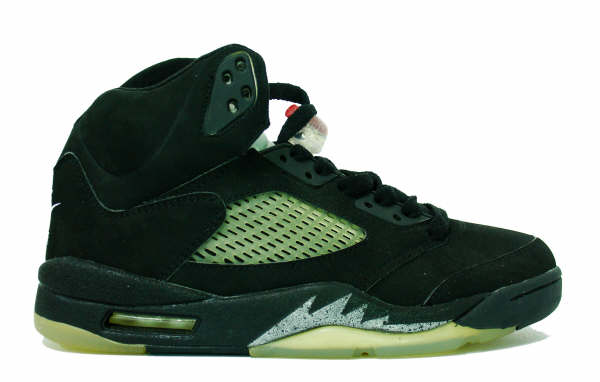

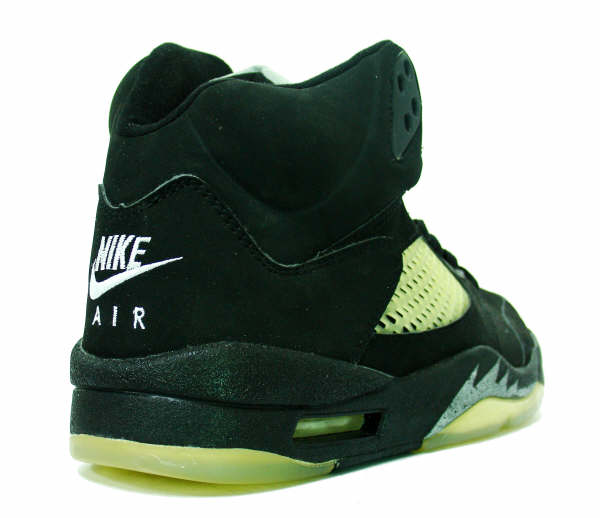
AIR JORDAN VI - Released February 1991
Yet another Hatfield design. The
Jordan VI kept the clear soles and lacelocks from the
Jordan V, but added a rubber tongue with two holes for getting the shoe on.
The pattern on the shoe was interesting. If you look at the shoe the
right way, the number 23 appears with the number 2 standing upright on the back
of the shoe and the number 3 laying down, facing the ground near the laces.
The retro release of the Jordan VI is exactly like the original release,
although a an incorrect sample caused quite an uproar
among fans of the Air Jordan line.
After seven years in the league, Michael leads
What is there to say else than Hatfield created another classic, the jordan VI . This time with a
rubber tounge featuring two holes which the bearer
could use to easily get the kicks on. He kept the idea with clear rubber soles
and lace locks from the V's but apart from that this felt like a brand new
The pattern on the jordan
VI was interesting. If you looked at it in different angels
and with a little bit of imagination you could see the number 23. The
figure two standing up on the back of the shoe and the figure three lying down
facing the ground close to the laces (soon there will be a picture illustrating
this).
The original Air

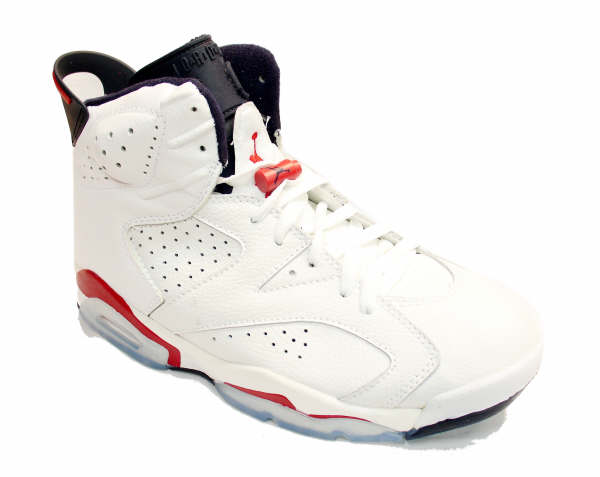

AIR JORDAN VII - Released February 1992
The Air Jordan VII seems to be Hatfields
fusion of the Nike Air Huarache and the previous
The Air Jordan VII was met with strong feelings of love or hate. This is
the first of the Air Jordans to create division among
the ranks of loyal fans and customers.
Michael wins his third MVP award, his sixth scoring title, a finals MVP
award, his second championship and his second Gold Medal. He ends an incredible
season by sinking 35 points in one half of game one in the finals against
Hatfield created a shoe, the Air Jordan VII with many similarities with
the previous Air
When Michael Jordan went to the Olympics with the Dream Team, Nike
released a special olympic color
combo of the Air Jordan VII 's. This model also
featured
The Air Jordan VII was one of the first models that really caused the
customers and collectors to take a stand. Some people straight up hated it and
others loved it more than any previous model.
Sure, taste is individual and previous models had also been met with
criticism but nothing as obvious as with the Air Jordan VII
's. Who knows, this might have been due to the fact that Jordan's
popularity was huge by now and that Air Jordan's now were exported to all four
corners of the globe making the customers a greater number than before.
Ever since the Air Jordan VII's taking a stand
when it comes to the design has been a lot more obvious and we've always seen
distinct pro and con divisions within the circle of customers.
The Air Jordan 7 was the 1992 version, and it originally sold for $125.
Most versions had "23" on the heel, but they also made a version with
"9" on the heel, for Michael's jersey number at the 1992 Barcelona
Olympics (the one known for the "sweats with the Reebok logo" flap,
where many of the Nike endorsers engaged in various tactics to obscure the
Vector logo). This is a rare and highly desirable version.
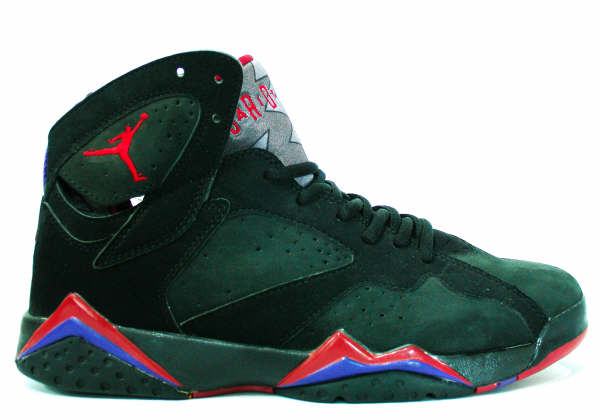



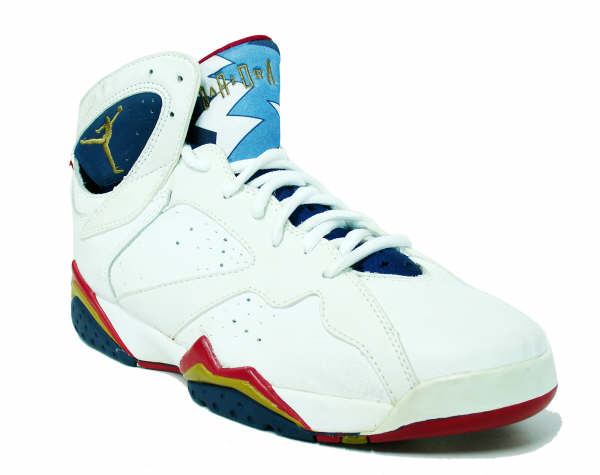

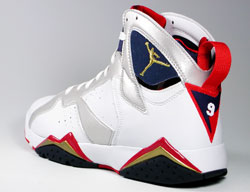

AIR JORDAN VIII -
Released February 1993
The eighth model of the Air Jordan could politely be called chunky. The base of
the shoe was clearly modeled on the design of the
Jordan XVII, but
the Air Jordan VIII added more colors and
details. Thick padding for and
criss-crossing Velcro straps over the upper made for a great fit but some
players experienced problems with heat buildup and a
clumsy feeling due to the weight
The Jumpman logo on this model vaguely resembles a
Peace sign, especially on the white/grey Retro version with its shaggy
carpet-like jumpman, leading to the Jordan VIIIs nickname: the flower-power Air Jordan.
Available in only three color combinations,
the Air Jordan VIII sold very well in its original and retro versions. The model has since been discontinued.
Michael Jordan continues his unmatched ability to take control of the
game and inspire greatness in his teammates. A
seven-time scoring champion, he achieves his highest finals scoring average
with 41 points against

|
|
|
AIR JORDAN IX - Released February 1993
On
Right Shoe:
ddi (French) – dedicated
fuerza (Spanish) – force
intenso (Italian) – intense
libert (French) – freedom
anmutig (German) - graceful
Left Shoe:
спорт (Russian) – sport
uhuru (Swahili) – independence
свобода
(Russian) – freedom
athletisch (German) – athletic
muundaji (Swahili) - ?
Nine years of refinement produces the 1993 Air
The Jordan IX being released was plain and sturdy and was the first Jordan IX
model that Michael did not wear in an NBA seasonal game (due to his retirement in
November 1993). They originally sold for $125. (Other people I knew agreed that
these were great shoes.) Here is the Air Jordan 9, updated in 2002 to the
Washington Wizards colors.
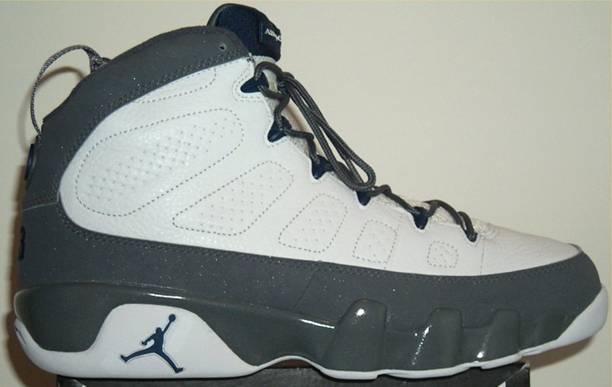

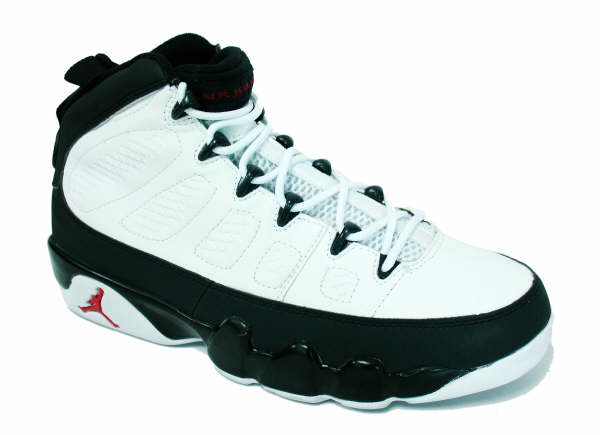

AIR JORDAN X - Released November 1994
Nike was caught off guard with Michael Jordans sudden return to the court. Before releasing the Jordan X, they
re-released several older
The Air Jordan VII was met with strong feelings of love or hate. This is
the first of the Air Jordans to create division among
the ranks of loyal fans and customers.
Expecting never to see the man in the game again, this year's shoe was
released with a retrospective of MJ's career. The
sole of this new AJ listed some of Michael's greatest achievements from each
year of his professional career. On
The Air Jordan X (10) was released in 1994 / 1995. Michaels
new baseball career was interrupted when the player strike took effect. Rumours
broke out that he would return to the game of basketball and on
It's apparent that Nike wasn't expecting to see
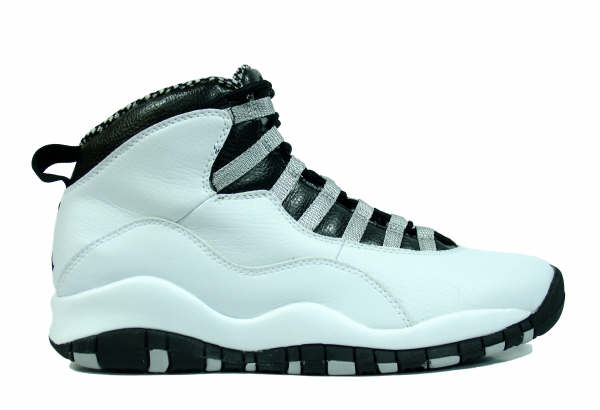
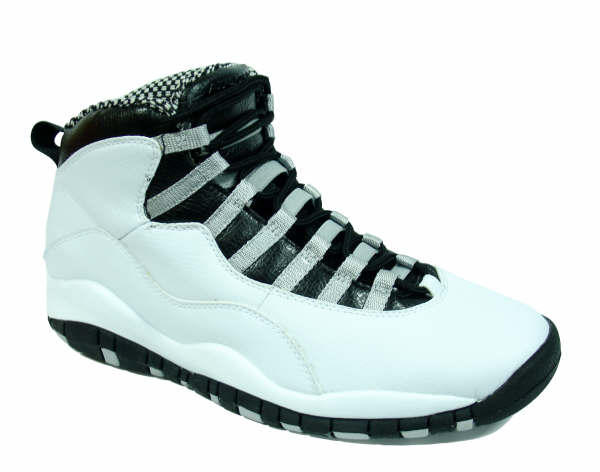

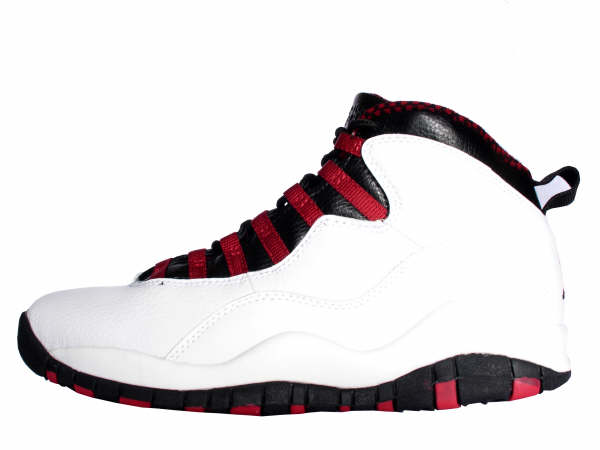
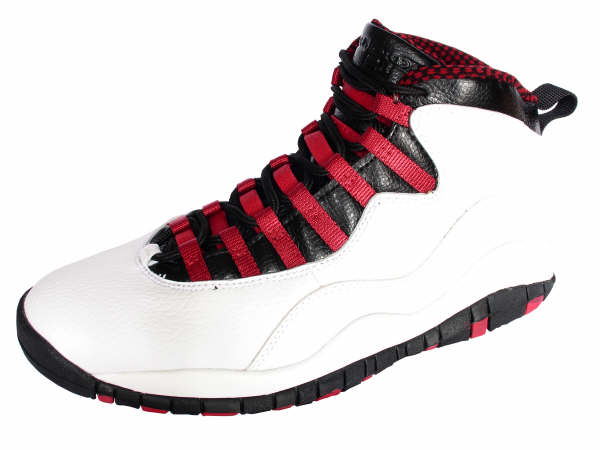
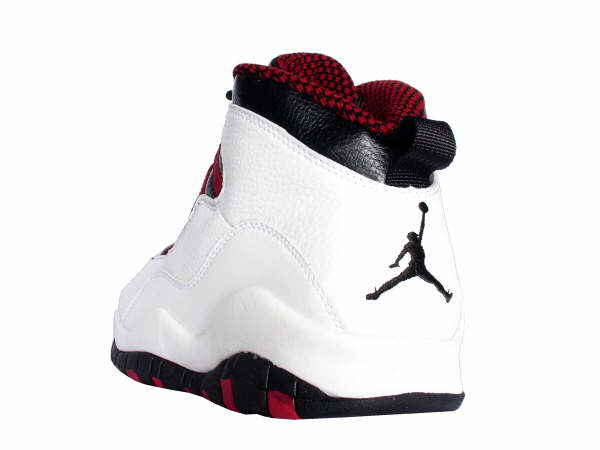
AIR JORDAN XI - Released November 1995
The Air Jordan XI heralded a triple comeback;
While the design of this model was premium, the quality was sadly
lacking and despite the release of low-top versions, the Jordan XI was not the
most popular of all the Air Jordan shoes.
When the Jordan XI's were retroed in 2000-2001
they became the fastest selling, most popular
Michael's intuitive insight of bringing a "formal look" to the
court, served as the inspiration for this remarkable rendition. Like the man,
the Air Jordan XI is sophisticated and without equal.
Michael Jordan was back and so was Tinker Hatfield. An amazing design with a
new patent leather and the return of the clear rubber sole made the Air Jordan
XI the most appreciated Air
But when the design stunned everyone, the durability and quality was
disappointing. Again the clear rubber soles easily yellowed and the patent
leather also tended to crack up and/or easily get scratched. The Air Jordan X1
had top design but it was lacking quality.
With the Air Jordan X1 's we also saw the
return of low-tops. Something that would follow the Air Jordan's all the way to
the XVI's (although skipping the XII's).
Michael was fined $5000 per game during the semifinals
in 1995 for wearing the white/black-dk concord ones.
He wore them twice and this was looked upon as uniform violation as the rest of
the Bulls wore entirely black shoes. (This kind of brings back memories from
when the I's were banned
from the NBA.)
Being fined two games was enough though and the next game he wore Anfernee Hardaway's shoes.
But did Nike enjoy MJ not wearing AJ's? Probably not as he got the "Space Jam's" for the
remaining games. The same shoes that could also be seen in the movie
Space Jam.
When the Air Jordan XI 's were retroed in 2000-2001 they would prove to become the retro
that sold in the highest quantity ever and also the fastest selling Air
There were also some made with
the number "45" (as Michael Jordan's "23" was not out of
retirement) but these are very rare. On the inside of the tongue, the label
states "Quality basketball products inspired by the greatest player
ever." (At least according to the marketing department
in
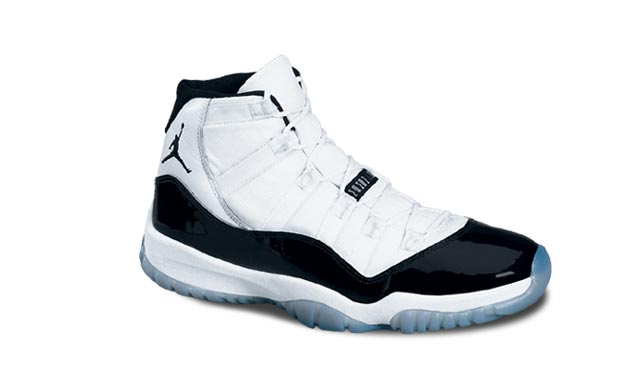
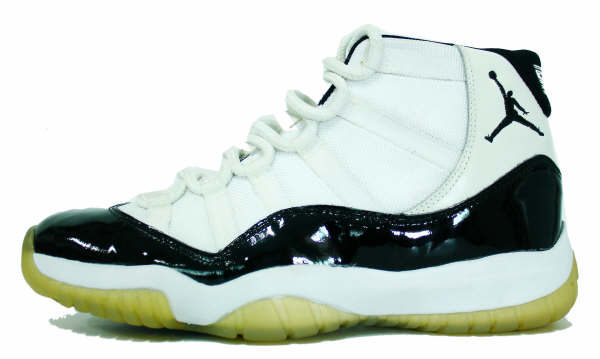
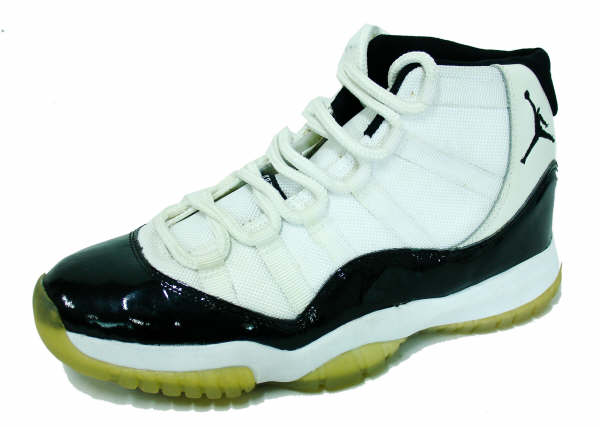
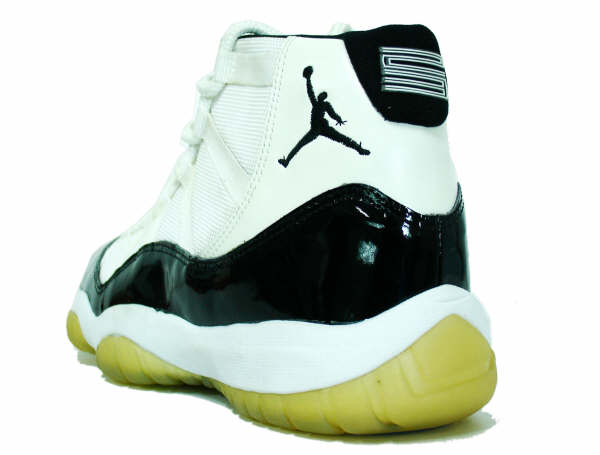

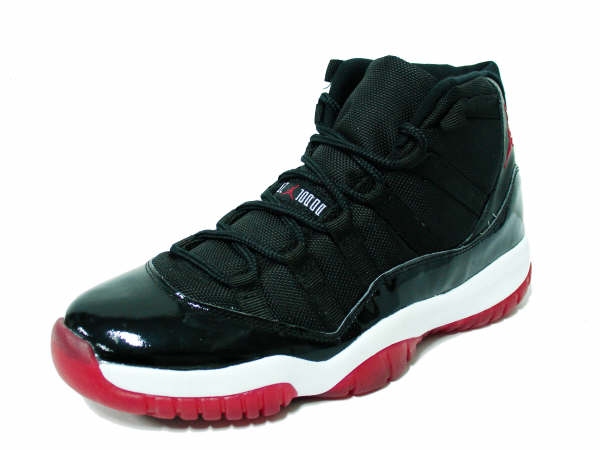
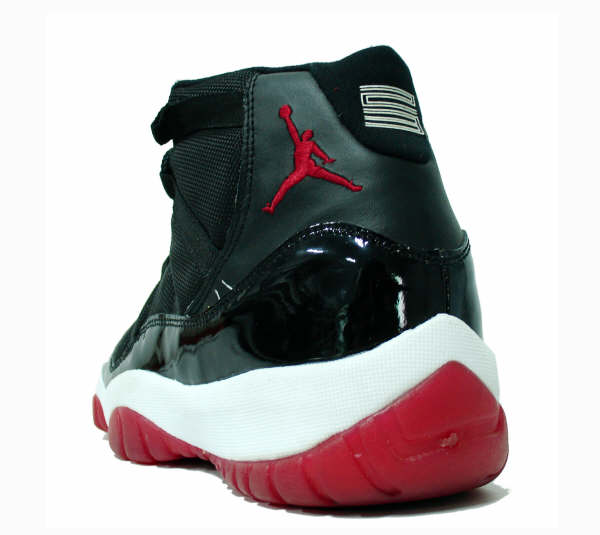
AIR JORDAN XII - Released November 1996
The Jordan XII was a completely new design for Air
The Jordan XII was the most durable Air
In September 1997 Nike decided to launch a new sub-brand of Nike called Jordan
Brand. The Jordan XII was the first
Michael continues to dominate on the court, and in game 5 of the Finals
against Utah, he reminds everyone why he is unstoppable. Michael plays through
the game with a severe stomach virus. Despite riding on no sleep, no food, and
no energy. Michael leads Chicago to victory with 38 points and a game-winning three-pointer.
While Nike did not reveal the JORDAN Brand
marketing plan until late 1997, there were earlier, tantalizing hints in the
products on store shelves.
While the Air Jordan 12 was still on store shelves, Nike brought forth the
JUMPMAN Pro. It was a shoe with many Air
This Air Jordan XII was again something totally new when it came to the
design. The way the ribbed leather seemed to go all the way to down to the
ground due to the match in color with the midsoles, really made people turn their heads. This unique
design was partly inspired by the flag of the Japanese Army & Navy in which
the red circle is surrounded by a "sunset".
The Air Jordan XII 's were also one of the most
durable Air Jordans to date. It seemed almost nothing
could break these shoes down. One major disadvantage was that they fairly
easily got dirty and were hard to clean. Especially the ones
with white midsoles/soles.
In September 1997 Nike decided to launch a new sub-brand of Nike called
Jordan Brand. This made the Air Jordan XII one of the first products that were a part of the Jordan Brand collection.
Probably due to this fact, the Air Jordan XII was the first Air
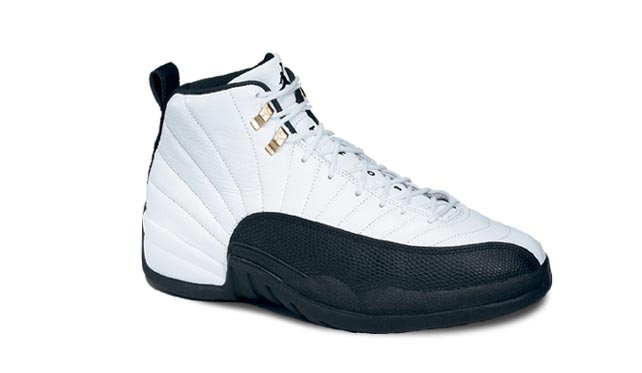
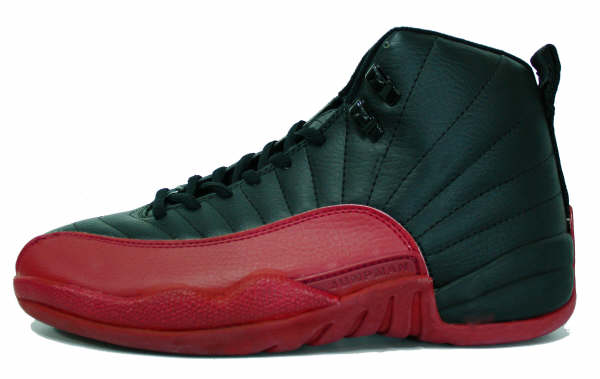

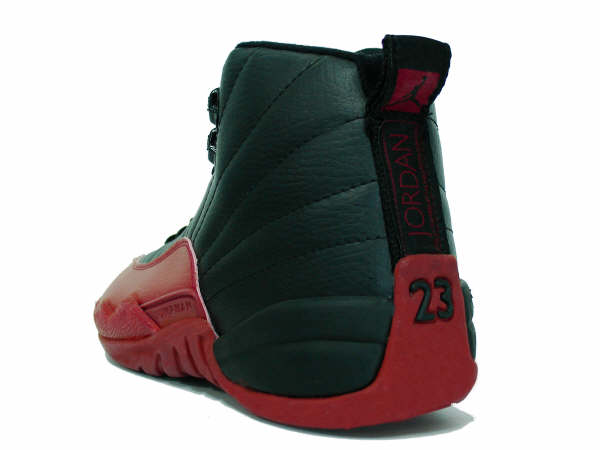
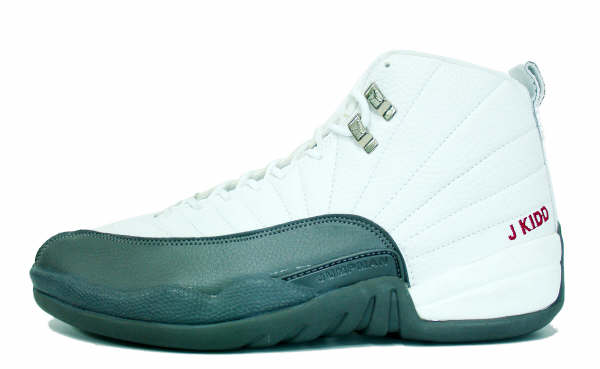
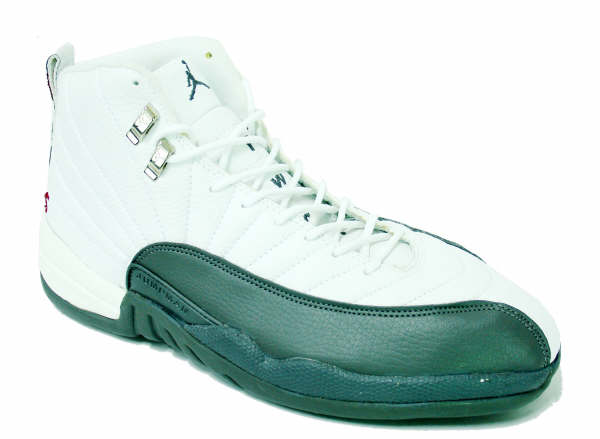

AIR JORDAN XIII - Released November 1997
Now that Nike and Air Jordan designer, Tinker Hatfield were a little
more prepared, they were able to keep producing original designs for the Nike
Air Jordan line.
One of the nicest features of this
The low-top versions of the Jordan XIII were released without this nifty
feature though, much to the disappointment of many.
Perhaps Michael's most famous shot ever took place in Game 6 of the Finals
against
Hatfield kept on making original designs. The Air Jordan XIII
's featured a nice hologram on the ankle and the design was said to be
inspired by a panther. The outsole with pads like a paw and
circles representing whiskers.
Two different low-top colors of the Air Jordan
XIII were also released to the public. These without the
hologram. The first Air
Note the round "ankle patch" near the back of the shoe. The
text and picture below describe it in more detail.
The "ankle patch" on the Air Jordan 13 is on the wrong side
and in the wrong place to be a structural ankle patch in the Converse
"Chuck Taylor" All Star tradition. It's a one-inch circular hologram
with three distinct layered images. From the back to the front, the hologram
shows:
A basketball.
The number "23" in a outlined block
font.
"Air
The effect is largely lost in a picture. However, the picture below is
an attempt to show the hologram. The number "2" and a portion of the
"Air
The sole picture collection shows the Air Jordan 13. Shortly after the
release of the Air Jordan 13, Nike started bringing the rest of the
"JORDAN Brand" clothing and shoe line to market. Nike markets these
products as if they are a completely separate brand, designated by the
"JUMPMAN" instead of the usual "SWOOSH."
Starting with the third color of Air
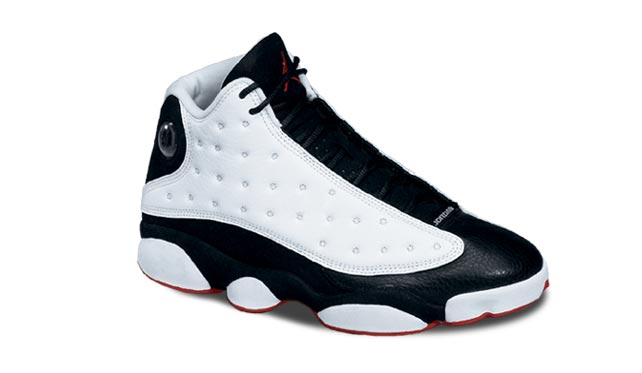
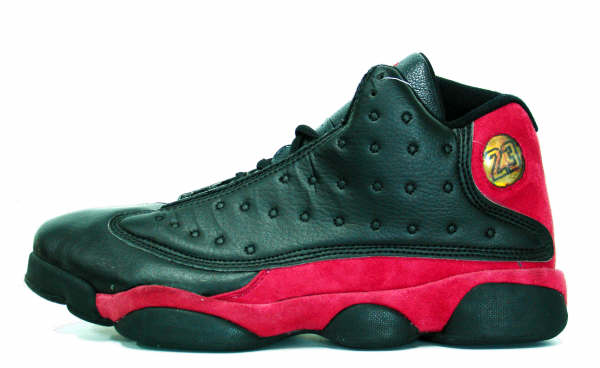

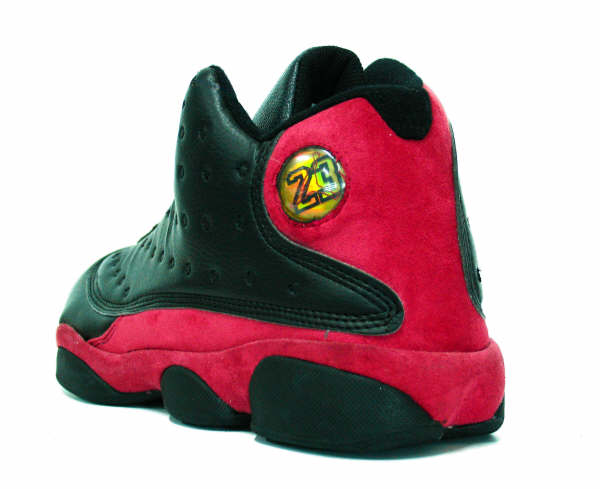
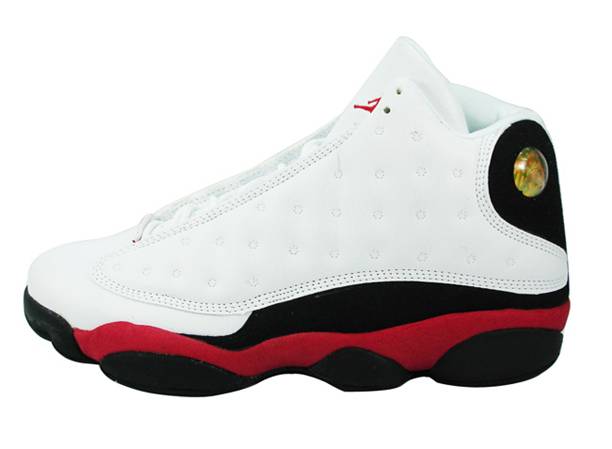
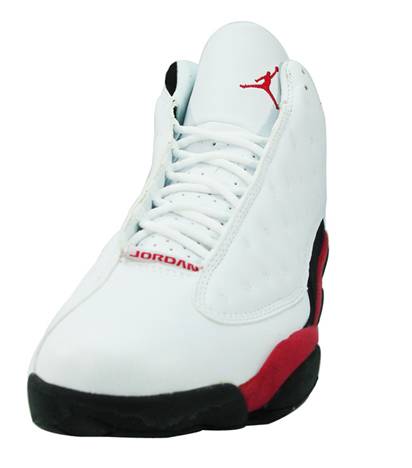
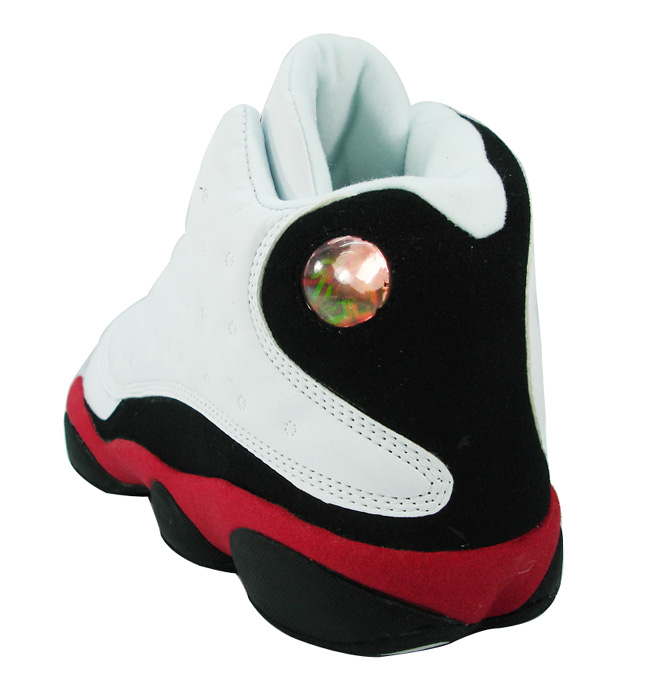
AIR JORDAN XIV - Released November 1998
The design of the Air Jordan XIV, inspired by Michael Jordans Ferrari 550M, was a stroke of sheer genius on the
part of Hatfield and fitting shoe to accompany
The Jordan XIV is a sleek, performance driven shoe that is as close to
perfection as weve tested.
Features include, laces with metal aglets (the
tips on the ends of the laces) and seven Jumpman
logos per shoes equaling a total of fourteen. Overall, the Jordan XIV is a stylish,
lightweight shoe that is perhaps the best Air
Inspired by Michael's love of cars, the AJ XIV takes on the stylish design of
Michael's very own Ferrari 550 M. As usual, it's a shoe to inspire greatness in
all players.
The design of the Air Jordans XIV was inspired by Michaels car, the Ferrari 550 M, and was made by Tinker
Hatfield together with Mark Smith. A fantastic stylish design and an awesome
shoe for Michael to end his NBA career in.
This was the first Air Jordans XIV that would
feature laces with metal tips. Something that both the XV's and XVI's designs also would
use.
The Air Jordan XIV 's also begun the trend of
having a number of things that would count towards the model# of the shoe. On
the Air Jordan XIV 's each shoe had seven jumpmans; ferrari-like shield,
insole, sole, back, 2 x lacetip and front. Counting
them on both shoes makes it a total of 14 (XIV) Jumpmans.
That summer, I was getting different reports about the price; some said $165,
others said $150. When the shoe came out in Fall 1998,
the ones that said $150 were right! (I'd suspect that Nike decided that a $165
shoe wouldn't help public relations. On the other hand, who would ever think
that the Air Jordan market would be price sensitive?)
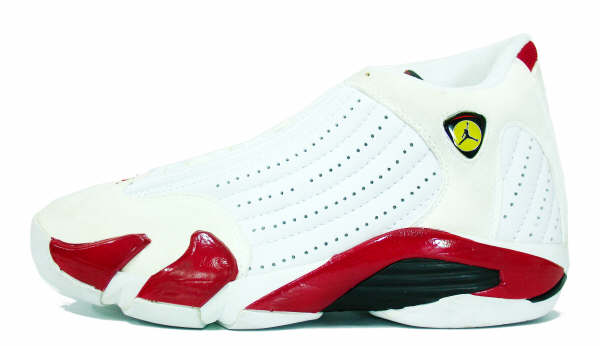
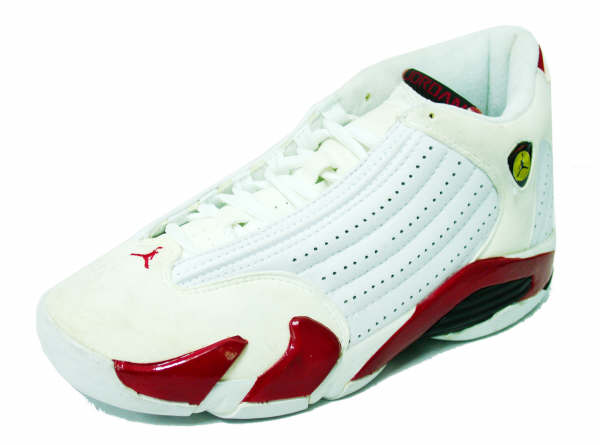
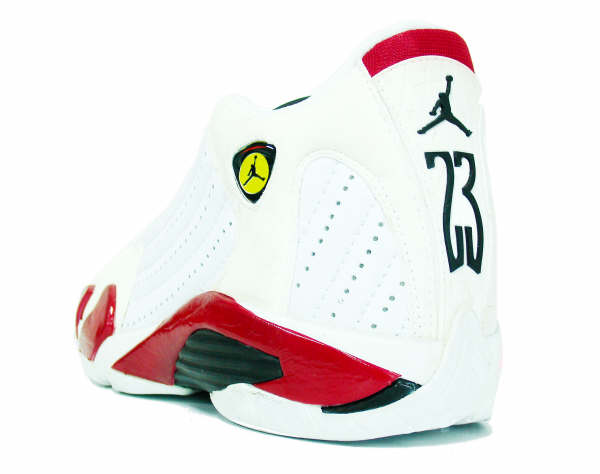
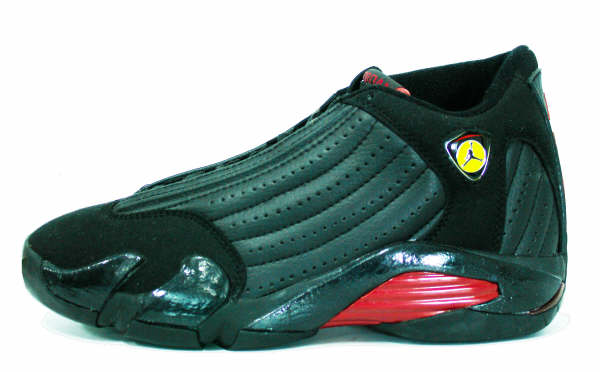
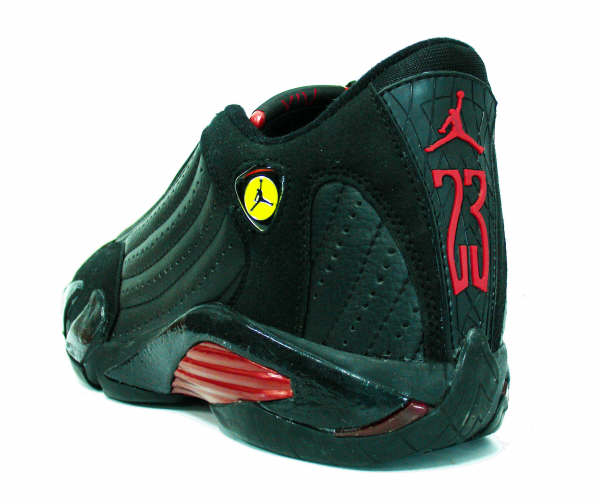
AIR JORDAN XV - Released November 1999
The Jordan XV was the first shoe released after its namesakes
retirement, but despite missing its endorser, the Air Jordan was a decent
product that sold fairly well. With a designer look, based on NASAs 1950s X-15 aircraft, the look of the shoe was a
radical change from its predecessors.
Modeled after the ultra-fast X-15 fighter jet, these aerodynamic kicks took off
like a shot. Despite Michael's absence from the game, these Air Jordans were as popular as ever.

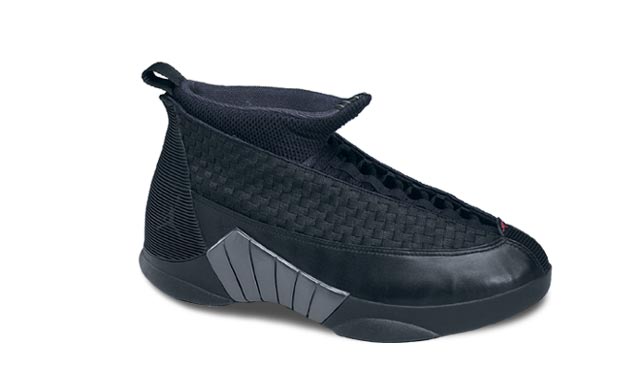
AIR JORDAN XVI - Released February 2001
Former Air
With a little fresh blood in the design process, the Jordan XVI was
perhaps the first truly fresh design since the Jordan III, despite the fact
that Smith decided to recycle a few of the design elements of earlier releases,
such as the clear soles and patent leather.
What made the Jordan XVI new was a removable gaiter/shroud, giving the
shoe two looks for the price of one.
Not only a stylish addition, this feature helped to control temperature and
comfort for the wearer. Like all new
things, this design had a few bugs to be worked out. The overall feel of the shoe was a little
stiff and the shroud easily came off during very active wear and the patent
leather didnt wear as well as other materials. Even with these problems, the overall concept
and design of the Air Jordan XVI was excellent and Wilson Smith certainly lived
up to the example of his predecessor.
The first shoe to incorporate a removable shroud these Air Jordans offered two unique looks. Perfect for on the court
or off the court, the XVI was like two shoes in one.
The Air Jordan XVI 's were designed by Nike's
Senior Footwear Designer Wilson Smith. This meaning it was the first design
since the III's that Tinker Hatfield wasn't behind.
Hatfield was said to have moved up and he left Smith with the hard task in
creating a revolutionary new design.
Smith decided to bring in a few design elements/fabrics from earlier
releases for the Air Jordans XVI. For instance we saw
the return of the clear rubber sole (V, VI, XI) and they also featured patent
leather (XI).
But what made the Air Jordan XVI 's unique was
the brand new gaiter/shroud that covered the shoe and that could be removed to
give the shoe a brand new look. Not only was this for stylish purposes, it also
had a thermal functionality.
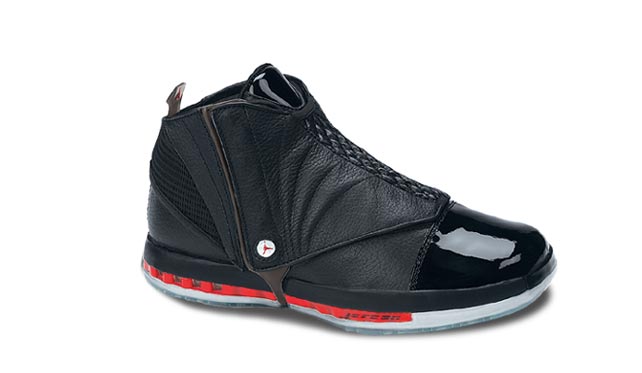
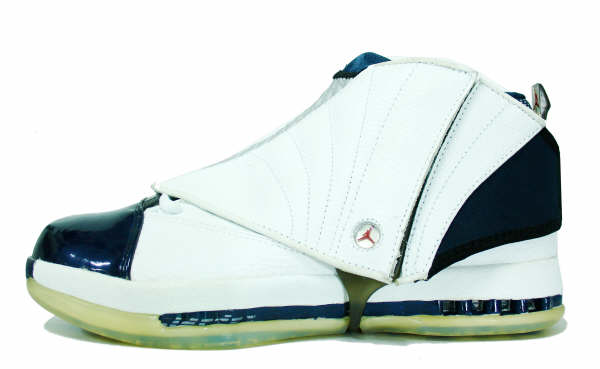
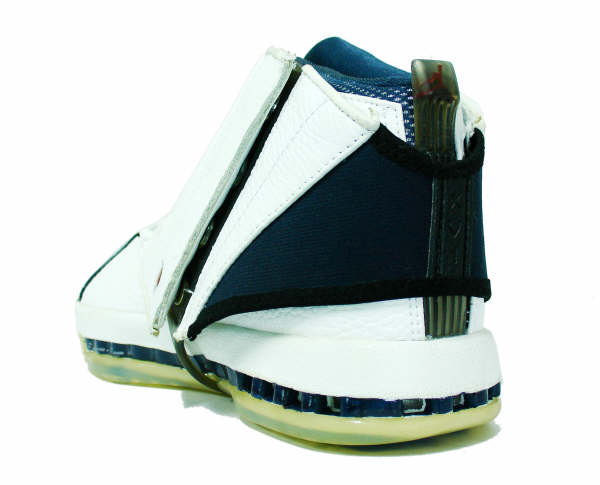
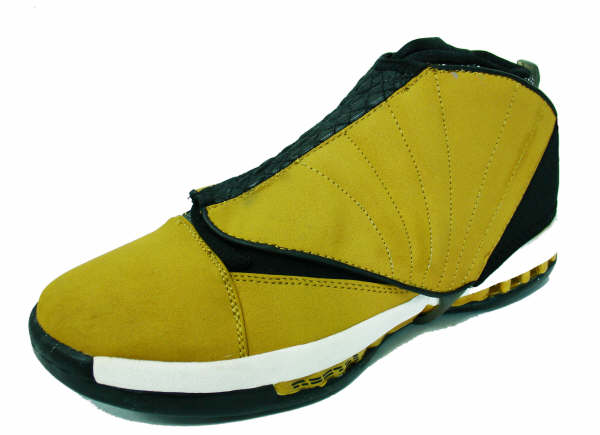
AIR JORDAN XVII - Released February 2002
According to jumpman23.com, the
Air Jordan XVII design was inspired by; "the fine details from an Aston
Martin, the smooth lines and flow of a jazz solo and the long Air Jordan
history of innovations in style."
Like the Jordan XVIs, the Jordan XVII came equipped
with a removable midfoot cover, giving the wearer two
looks for this model. This
"I am returning as a player to the game I love". Seeing an
opportunity to teach the younger players, Michael returns to the game with a
new team but that same drive. Leading
The Air Jordan XVII design was said to be inspired by three things; "the
fine details from an Aston Martin, the smooth lines and flow of a jazz solo and
the long Air
Well, if the Air Jordan XVI's were equipped
with a gaiter/shroud that was removable and that would cover almost more than
half of the shoe, the Air Jordan XVII 's were no
worse. With a removable midfoot cover you were once
again given the power to choose whether or not the laces should be visible!
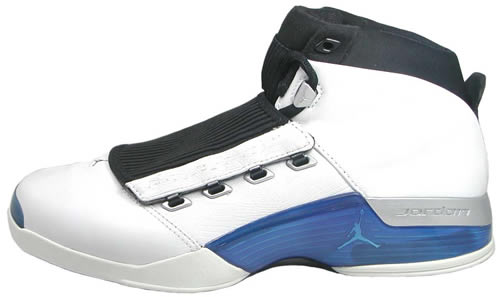

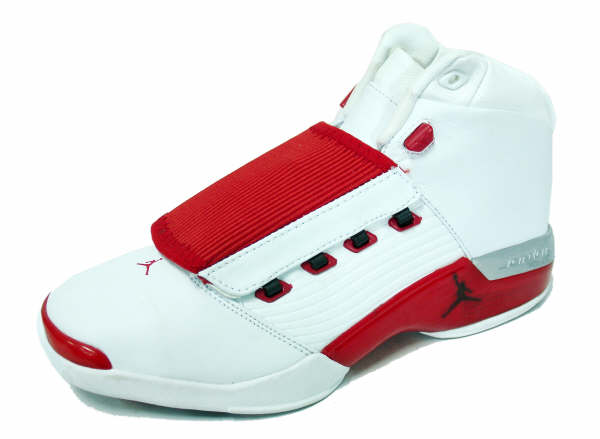
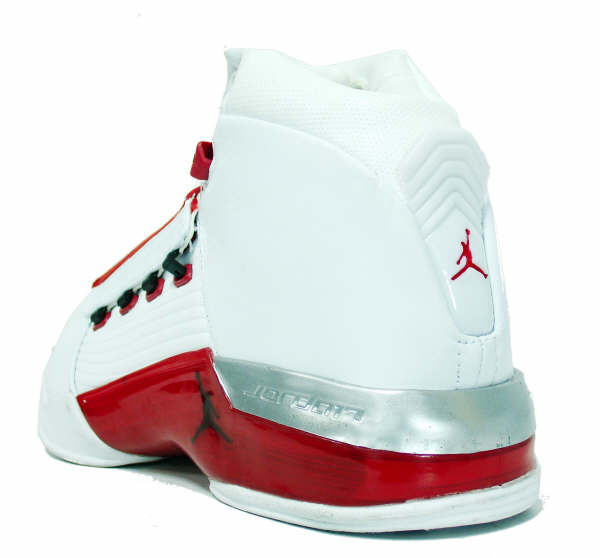
AIR JORDAN XVIII - Released February 2003
The Jordan XVIII is the brainchild of new Senior Jordan Footwear
Designer, Tate Kuebis. The inspiration for this model is said to be
a number of things, but primarily a design based on the sleek lines of the
racing world and the quality of Italian dress shoes. Mostly, the Air Jordan
XVIII is known for its unique accessories, a pull-out opening box and a brush
and towel for cleaning the shoes.
Drive the 2003 Air
Creator of the design of the Air Jordan XVIII was Tate Kuerbis
(Jordan Senior Footwear Designer). A person that had been
part of the Air Jordan footwear design team since 1999 and with Nike since
1995. The inspiration of the design is a combination for a number of
things; Sleek racing lines of the auto world, Carbon fiber-based
monocoque of F1 race cars, Race car driving shoes
(rubber heel wrap) and Fine Italian dress shoes (bold stitching on the soles).
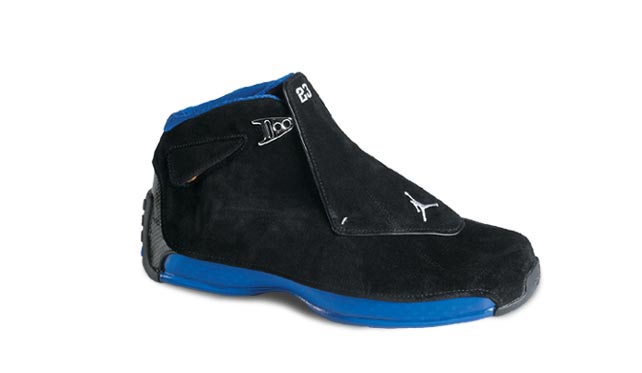
AIR JORDAN XVIII.5
While both the Jordan XVI and the Jordan XVII were later released with modified
models called the "+" model, the Jordan XVIII design was so radically
altered that Nike released a whole new shoe.
The basic
design was similar, but the

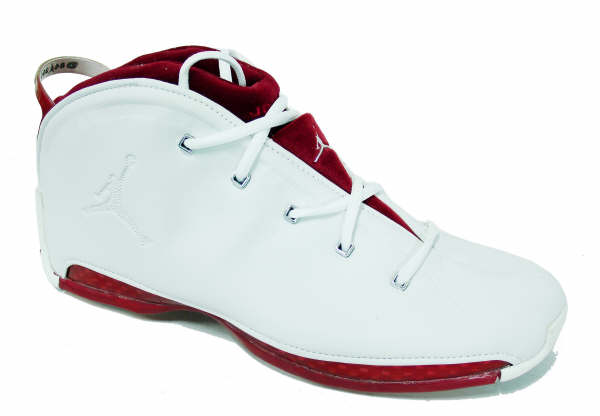
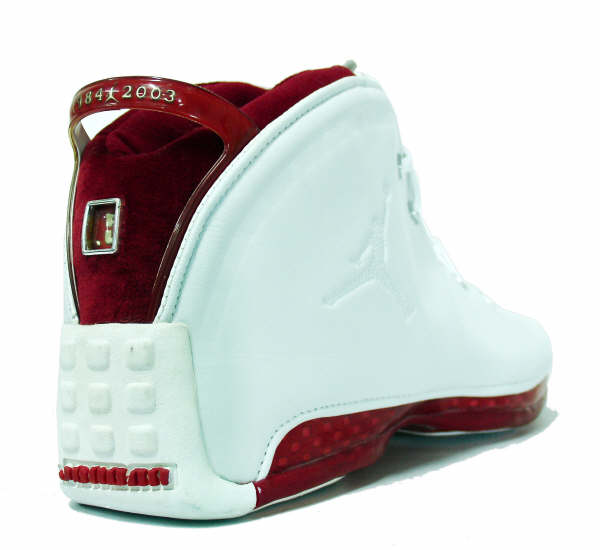
AIR JORDAN XIX - Released Unknown
The futuristic Air Jordan XIX continues in the grand
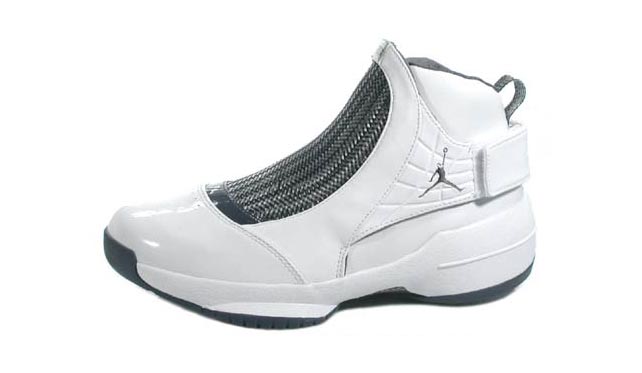
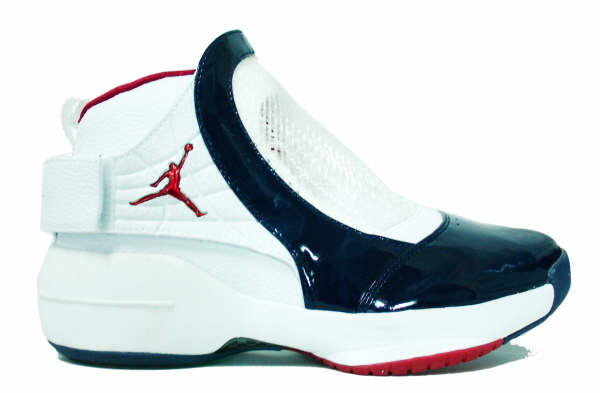
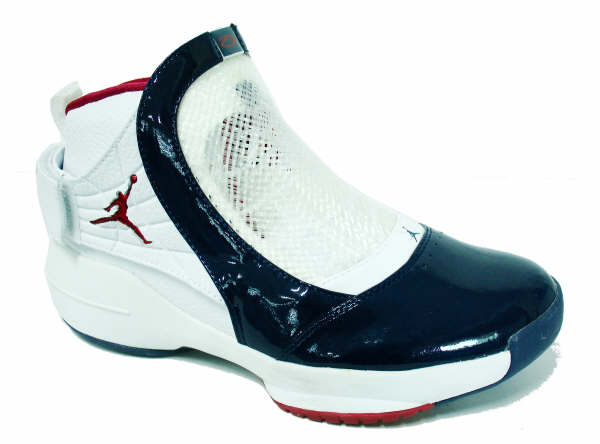
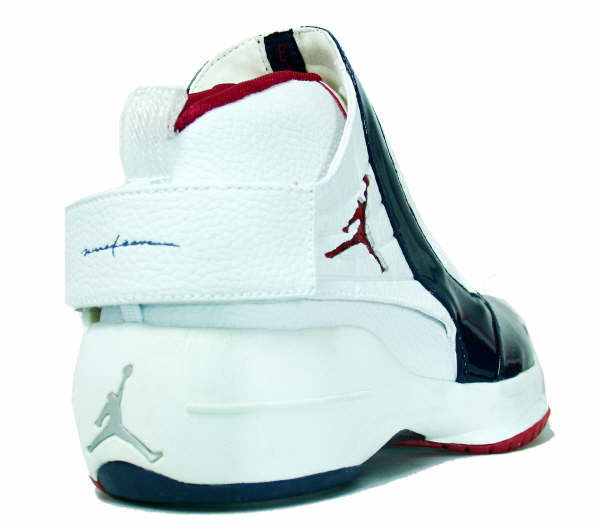
AIR JORDAN XX - Released 2005
This is a shoe designed and dedicated to
